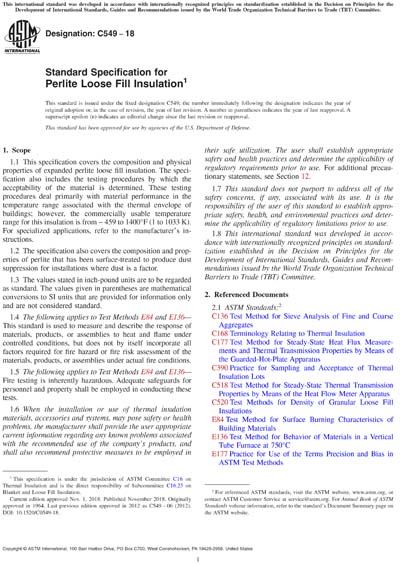Historical
ASTM C549-18
Standard Specification for Perlite Loose Fill Insulation
1.1 This specification covers the composition and physical properties of expanded perlite loose fill insulation. The specification also includes the testing procedures by which the acceptability of the material is determined. These testing procedures deal primarily with material performance in the temperature range associated with the thermal envelope of buildings; however, the commercially usable temperature range for this insulation is from − 459 to 1400°F (1 to 1033 K). For specialized applications, refer to the manufacturer's instructions.
1.2 The specification also covers the composition and properties of perlite that has been surface-treated to produce dust suppression for installations where dust is a factor.
1.3 The values stated in inch-pound units are to be regarded as standard. The values given in parentheses are mathematical conversions to SI units that are provided for information only and are not considered standard.
1.4 The following applies to Test Methods E84 and E136—This standard is used to measure and describe the response of materials, products, or assemblies to heat and flame under controlled conditions, but does not by itself incorporate all factors required for fire hazard or fire risk assessment of the materials, products, or assemblies under actual fire conditions.
1.5 The following applies to Test Methods E84 and E136—Fire testing is inherently hazardous. Adequate safeguards for personnel and property shall be employed in conducting these tests.
1.6 When the installation or use of thermal insulation materials, accessories and systems, may pose safety or health problems, the manufacturer shall provide the user appropriate current information regarding any known problems associated with the recommended use of the company's products, and shall also recommend protective measures to be employed in their safe utilization. The user shall establish appropriate safety and health practices and determine the applicability of regulatory requirements prior to use. For additional precautionary statements, see Section 12.
1.7 This standard does not purport to address all of the safety concerns, if any, associated with its use. It is the responsibility of the user of this standard to establish appropriate safety, health, and environmental practices and determine the applicability of regulatory limitations prior to use.
1.8 This international standard was developed in accordance with internationally recognized principles on standardization established in the Decision on Principles for the Development of International Standards, Guides and Recommendations issued by the World Trade Organization Technical Barriers to Trade (TBT) Committee.
Content Provider
ASTM International [astm]






